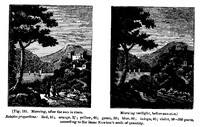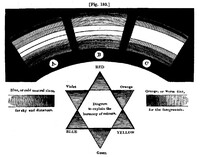Having placed a piece of dark cloth on a wall opposite to the light, I fastened a sheet of white paper in the middle of it; this I looked at through a prism held across my eyes a little above them, when I observed the paper took the curvature of a rainbow: from the upper edge proceeded shades of red-brown, terminating in yellow, and from the lower edge, shades of grey, terminating in blue, as I have shewn at C, in the annexed sketch [fig. 180]. This I observed under various lights, and remarked that, before sun-rise, no red appeared in the brown, and no violet in the grey shades; but they were exactly the same tints which I use in shading and finishing my sketches. I always use for my foregrounds, a warm brown, and for my distances, a cold grey, or neutral tint, and afterwards glaze over the whole with colour; and these two tints exactly coincide with those shewn at C, where a broad mass of white appeared betwixt them. By gently turning the prism, I found that I could contract this white space, as shewn at B; and as the sun began to illumine the horizon, I perceived red in the upper edge, and violet in the lower; but no green appeared, till, by gently turning the prism a little more, I brought the blue and yellow into contact, when the rainbow was completed in all its natural colours, as represented at A. I then considered how I could avail myself of this discovery to facilitate the mechanical process of printing and colouring many thousand plates, to make a fac-simile of my sketches: this I shall endeavour to explain by the annexed two landscapes [fig. 181], which are supposed to represent the same scene before and after sun-rise; that is, before and after the natural process of colouring takes place. The twilight scene is finished with the two neutral tints, and a harmonizing wash thrown over the whole; the other is also finished with the same two neutral tints, and afterwards washed or glazed over with the colours, in the order described in the diagram, beginning with red, then orange and yellow; in the foreground, with blue and violet, for the sky and distances. By this pro- cess, in the middle of the picture, green will prevail, partaking more of yellow near to, and more of blue as it recedes from, the eye; still bearing in mind that all objects will partake of their natural colour: thus, a red cloak must be red, and a green tree must be green, till its distance, or the intervening mass of vapour, called aerial perspective, takes away colour, and blends it with the neutral tint.



